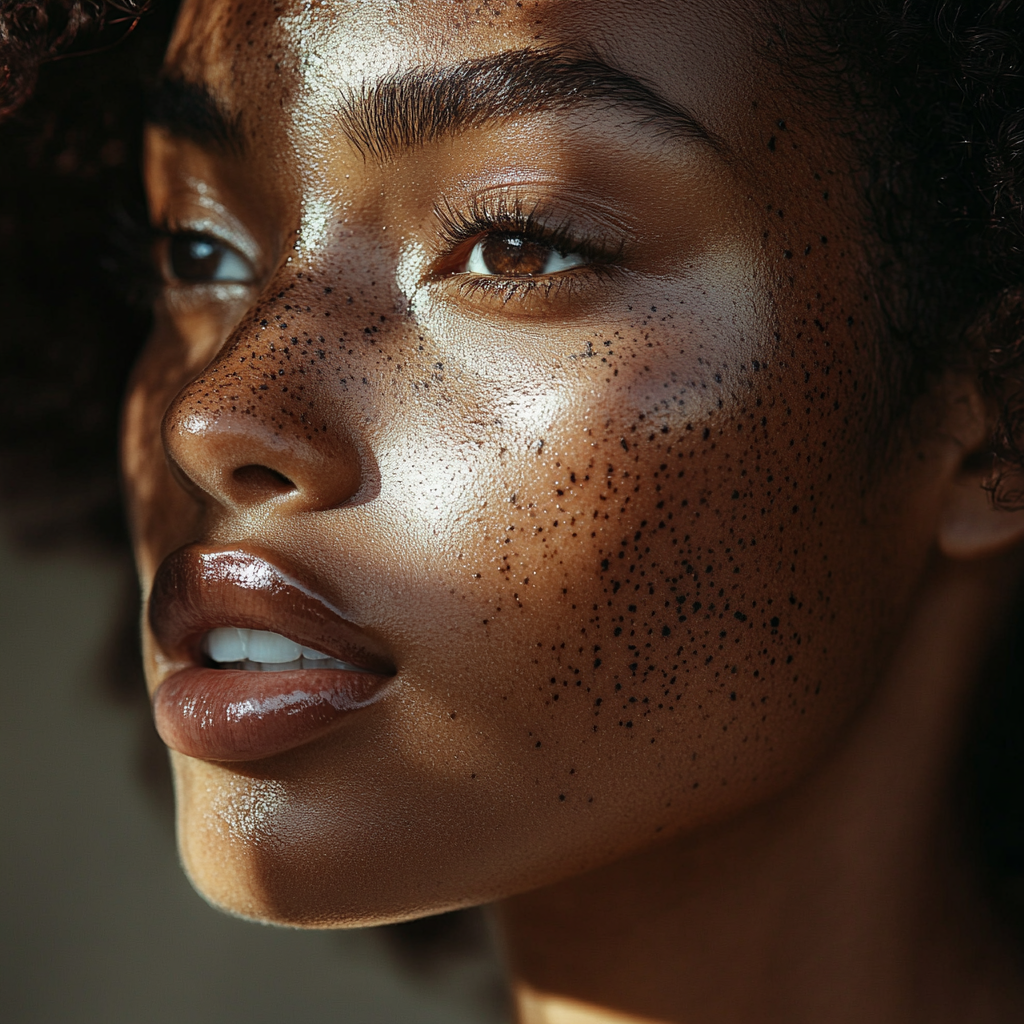
Unmasking the Melanin Mystery
Hyperpigmentation and dark spots, they might seem like they’re the same thing, but they’re not. Have you ever looked in the mirror and wondered, “What are these pesky dark spots doing on my skin?” It’s a common concern, especially for Black women. Understanding the difference between hyperpigmentation and dark spots is crucial to choosing the right skincare routine and products. Let’s dive into the world of hyperpigmentation and dark spots, unraveling the mysteries behind these skin changes.
Hyperpigmentation: The Overachiever
Hyperpigmentation is a broad term that refers to areas of the skin that become darker than the surrounding skin. Hyperpigmentation is essentially when your skin produces more melanin than usual. Melanin is the pigment that gives your skin its color. Think of it as your skin’s personal artist, deciding how light or dark your complexion will be. When melanin goes into overdrive, it can create patches of darker skin.
The Science Behind Hyperpigmentation and Dark Spots
Let’s get a little scientific. Hyperpigmentation occurs when melanocytes, the cells responsible for producing melanin, increase their activity. This can be triggered by various factors, including:
Sun exposure, Hormonal changes, Inflammation and Medications.
Types of Hyperpigmentation
Not all hyperpigmentation is created equal. It’s essential to recognize the different types, as they require different approaches for treatment:
- Post-Inflammatory Hyperpigmentation (PIH): This type occurs after an injury or inflammation of the skin. Common causes include acne, eczema, or a cut. Once the inflammation subsides, the skin overproduces melanin as it heals, leaving behind dark spots or patches. PIH is especially common in Black women because our skin is more reactive to trauma.
- Melasma: Often referred to as the “mask of pregnancy,” melasma is a type of hyperpigmentation triggered by hormonal changes. It’s common during pregnancy or when taking birth control pills. Melasma usually appears as larger patches of darkened skin, often on the face.
- Sun-Induced Hyperpigmentation: Excessive sun exposure can lead to an overproduction of melanin, resulting in sun spots or freckles. For Black women, even minimal sun exposure can trigger this type of hyperpigmentation, making sunscreen a must-have in your daily routine.
- Medications: Certain medications can cause side effects like hyperpigmentation.
Dark Spots: The Uninvited Guests
Dark spots, on the other hand, are specific areas of hyperpigmentation. They can appear as flat, dark patches on your skin. These uninvited guests can be caused by a variety of factors, including sun damage, acne scars, hormonal changes and and even bug bites. They specifically refer to small, localized areas where melanin production has gone into overdrive. They are essentially the aftermath of hyperpigmentation, left behind after the skin has dealt with inflammation or injury.
Unlike larger patches of hyperpigmentation, dark spots are usually smaller and more concentrated. They’re those stubborn little marks that linger long after a pimple has healed or a rash has cleared up. For many Black women, dark spots are a persistent issue, as our skin tends to hold onto the effects of trauma more so than lighter skin tones.
The Great Debate: Hyperpigmentation and Dark Spots
So, what is the difference between hyperpigmentation and dark spots? Think of hyperpigmentation as the broad category, and dark spots as a specific type within that category. Hyperpigmentation can manifest as large patches, entire areas of skin, or small spots, while dark spots are usually the result of a specific event, like a breakout or a cut.
In simpler terms, all dark spots are a form of hyperpigmentation, but not all hyperpigmentation manifests as dark spots. Hyperpigmentation covers a wider spectrum, including conditions like melasma or larger post-inflammatory patches, while dark spots are the more localized remnants of skin trauma.
Why Black Women Are More Prone to Hyperpigmentation and Dark Spots
Black skin is beautiful and resilient, but it’s also more prone to hyperpigmentation and dark spots. This is because our skin produces more melanin than lighter skin tones. While this protects us from sun damage, it also makes us more susceptible to hyperpigmentation when melanin production goes haywire.
Why Understanding the Difference Matters
Understanding the difference between hyperpigmentation and dark spots is vital because it informs how you treat them. Different types of hyperpigmentation may require different treatments, and what works for dark spots might not be as effective for other forms of hyperpigmentation.
For instance, treating dark spots often involves using targeted spot treatments, such as serums containing ingredients like vitamin C, niacinamide, or hydroquinone. These ingredients work to fade the concentrated areas of excess melanin. On the other hand, treating broader hyperpigmentation might require more comprehensive solutions, such as chemical peels, laser therapy, or prescription-strength creams.
Tackling Hyperpigmentation and Dark Spots: A Personalized Approach
Both hyperpigmentation and dark spots can be managed and even prevented with the right approach. Here’s how:
1. Sunscreen is Non-Negotiable
For Black women, protecting your skin from the sun is crucial. Even though our skin contains more melanin, which provides some natural protection, we’re still susceptible to UV damage. Sunscreen not only prevents hyperpigmentation from worsening but also helps to protect your skin from new spots forming. Make sure to use a broad-spectrum sunscreen with at least SPF 30 every day.
2. Incorporate Brightening Ingredients
Ingredients like vitamin C, kojic acid, licorice extract, and niacinamide are excellent for brightening the skin and fading hyperpigmentation. These ingredients inhibit melanin production, helping to lighten existing dark spots and prevent new ones from forming.
3. Exfoliation is Key
Regular exfoliation helps to speed up the skin’s natural turnover process, allowing dark spots to fade more quickly. However, be gentle! Over-exfoliation can irritate the skin and potentially cause more hyperpigmentation. Look for gentle chemical exfoliants like glycolic acid or lactic acid, which are effective without being too harsh on the skin.
4. Consider Professional Treatments
If at-home treatments aren’t giving you the results you want, consider seeing a dermatologist. Professional treatments like chemical peels, microdermabrasion, and laser therapy can provide more significant results, particularly for stubborn hyperpigmentation.
5. Be Patient and Consistent
Treating hyperpigmentation and dark spots takes time, especially for Black women, as our skin can be slower to respond to treatments. It’s essential to be patient and consistent with your skincare routine. Results may not be immediate, but with dedication, you’ll see improvement over time.

My Personal Journey with Hyperpigmentation and Dark Spots
As a Black woman, I know the frustration of dealing with hyperpigmentation and dark spots firsthand. I remember waking up one morning after a breakout had finally cleared, only to find those annoying little dark spots staring back at me in the mirror. It felt like they were mocking me, reminding me of the battle my skin had just fought. But over time, with the right products and a lot of patience, I began to see those spots fade. The journey wasn’t easy, but it was worth it.
I also learned the importance of sunscreen the hard way. For years, I believed the myth that Black women don’t need sunscreen, only to realize that my lack of sun protection was making my hyperpigmentation worse. Now, sunscreen is the first thing I reach for every morning, and my skin is so much better for it.
Inspiring Stories of Black Women Overcoming Hyperpigmentation
Let’s hear from some inspiring Black women who have conquered hyperpigmentation and dark spots:
- Aisha’s journey: Aisha, a 32-year-old from Nigeria, struggled with hyperpigmentation for years. After trying various treatments, she finally found relief with a combination of sunscreen and a prescription retinoid.
- Maya’s transformation: Maya, a 25-year-old from the United States, had acne scars that left dark spots on her face. She underwent laser therapy and now confidently flaunts her clear skin.
Conclusion: Embrace Your Skin’s Journey
Hyperpigmentation and dark spots are common concerns, especially for Black women, but they don’t have to define your skin’s story. By understanding the difference between hyperpigmentation and dark spots, you can take control of your skincare journey and work towards the clear, even-toned skin you deserve. Remember, your skin is unique, and it deserves to be treated with love, care, and the right knowledge. Embrace the process, be patient with yourself, and know that every step you take brings you closer to your skin goals.


